We’ve talked a lot about solar power on this blog over the years, and we’re big fans. We’ve got what for us is the ultimate RV solar panel system, and it has served us very well overall. But there’s no getting around the fact that the sun goes down every night, and that clouds, rain, trees, and other things that interfere with the sun happen regularly. We recently read about an innovative portable RV wind turbine, and it got us thinking – would a wind turbine be a good choice for RVers and campers?
Let’s take a look!
- 1) What Is an RV Wind Turbine?
- 2) How Does an RV Wind Turbine Work?
- 3) Is a Wind Turbine Capable of Powering an RV?
- 4) Can I Use a Wind Turbine and a Solar Panel System Together?
- 5) What’s the Downside of RV Wind Turbines?
- 6) Are There Upsides To RV Wind Turbines?
- 7) Are There Small Portable Wind Turbines for Campers?
- 8) Is an RV Wind Turbine a Good Choice for RVers and Campers?
- 9) Have You Tried Harnessing the Power of the Wind?
What Is an RV Wind Turbine?
An RV wind turbine is essentially a portable windmill that uses the power of the wind to generate electricity to power your RV’s devices and appliances when you’re off-grid.
An RV wind turbine is usually mounted on the roof of the RV, mounted to the RV ladder, or sometimes on a pole that stands independent of the rig (using either a hitch-mounted flag pole holder or one you can park the RV’s tire on).
A wind turbine does the opposite of what a fan does. A fan uses electricity to create wind, while a wind turbine uses wind to create electricity.
Let’s take a closer look…
How Does an RV Wind Turbine Work?
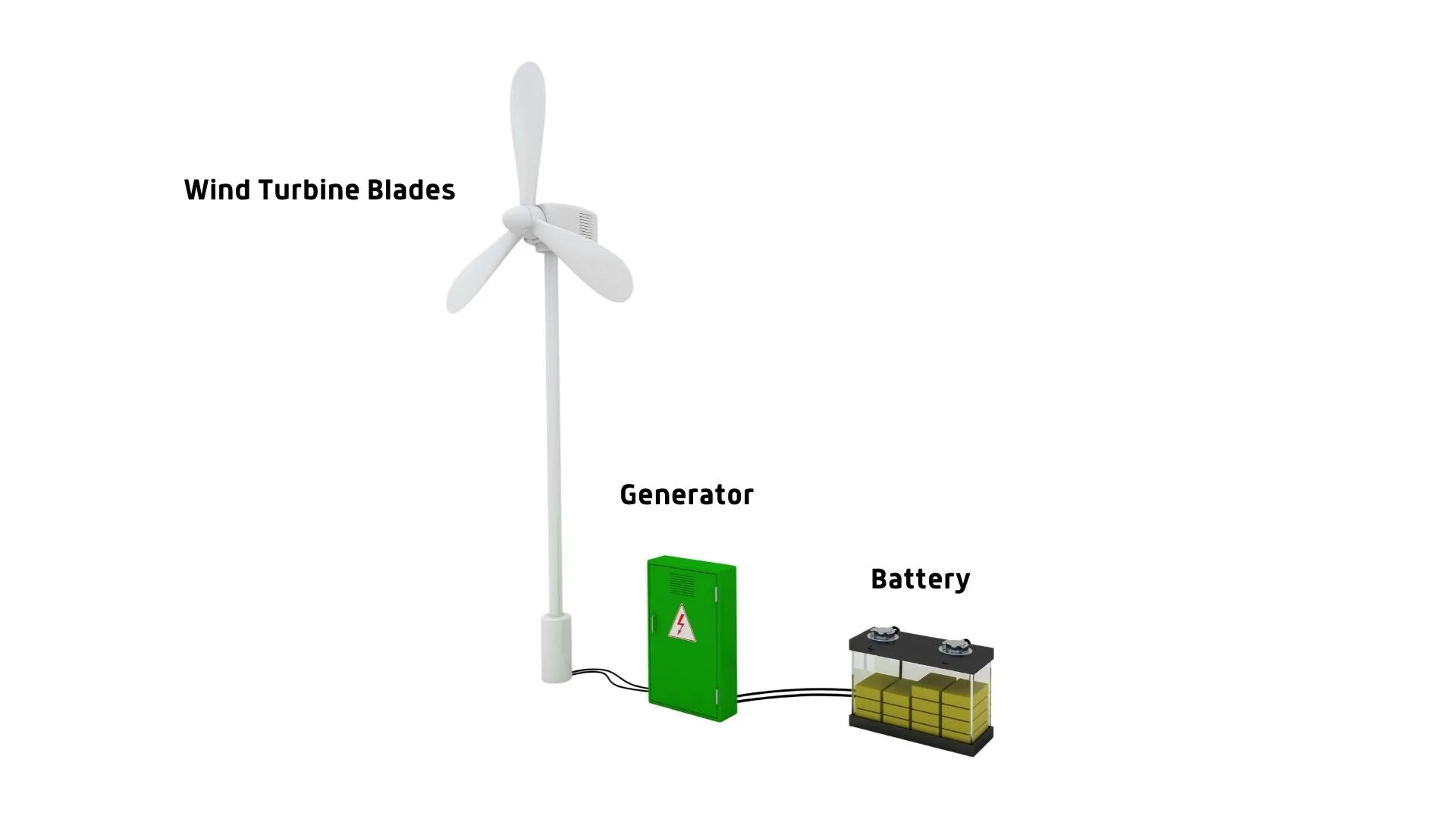
The wind turns the blades of the turbine which in turn generates energy that is stored in a battery.
A wind turbine has large blades that turn by the power of the wind. As the blades spin, the aerodynamic force of the rotor blades turns the generator, creating electricity. The faster the rotor blades spin, the more electricity is generated.
RV wind turbines are usually capable of generating no more than a few hundred watts at 12V or 24V.
Is a Wind Turbine Capable of Powering an RV?
In theory, a wind turbine can power an RV. But in real-world practice, it’s not quite as smooth a process as one might think, simply because the amount of electricity generated by a wind turbine that’s small enough to be easily portable isn’t all that much… and is very much dependent on the weather. Depending on how much power you need to generate, and how cooperative the weather is, you could easily find yourself short on power.
The cool thing is that though the sun goes down at night, and thus doesn’t generate solar power, wind can continue through the night. This means a wind turbine can continue to generate electricity.
But because wind turbines only generate power when the wind is blowing, it’s important to connect an RV wind turbine to a battery bank to store that energy for later use. Some RV wind turbines plug directly into an RV house battery bank, however, it’s more efficient to connect the turbine to a charge controller just as we do with solar panels. This not only increases efficiency but also protects the battery bank. Many RV wind turbine systems include a charge controller for this reason.
Can I Use a Wind Turbine and a Solar Panel System Together?
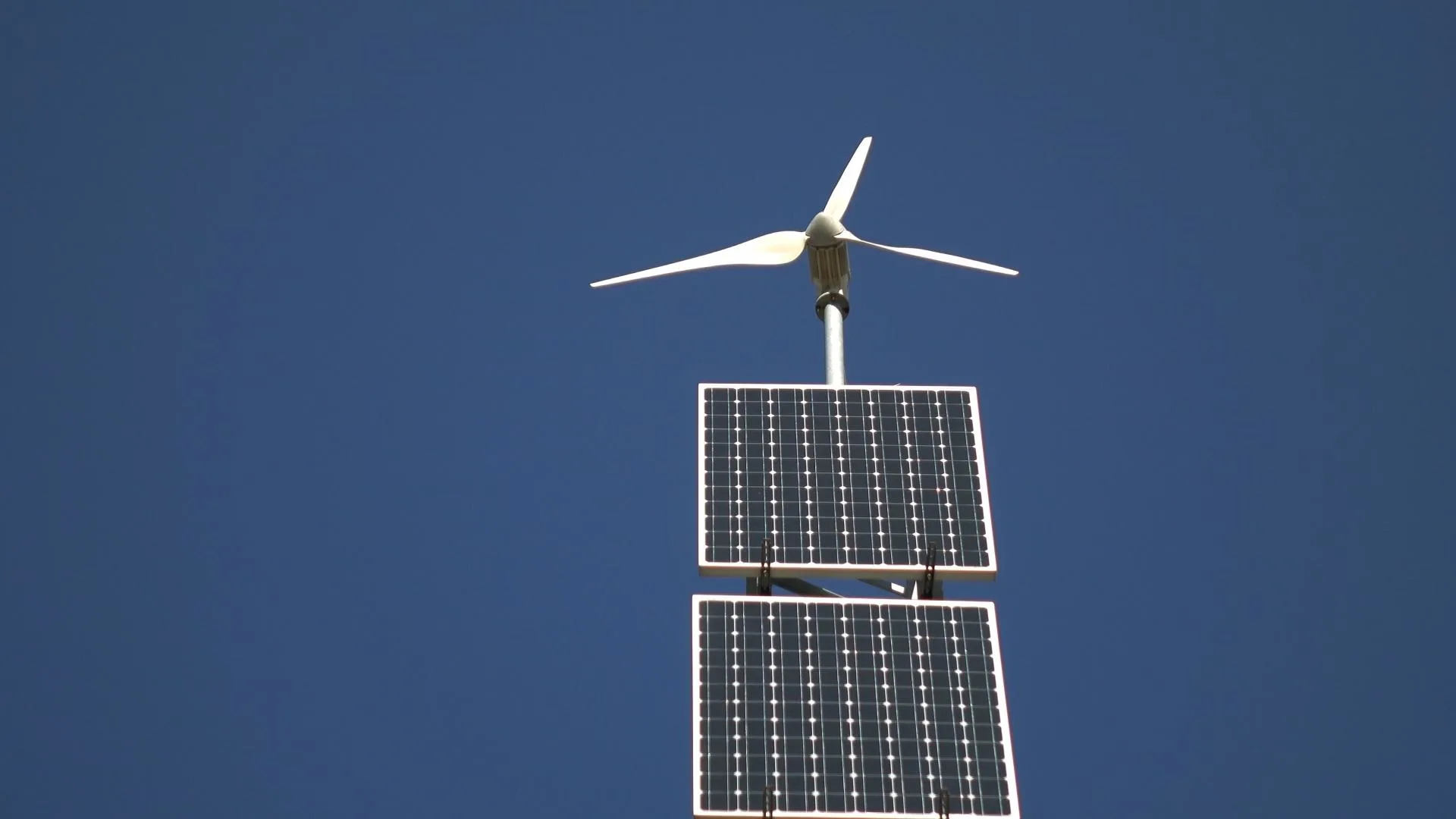
There are hybrid systems that combine a wind turbine with one or more solar panels. There are some kits for portable hybrid systems on the market.
Some (but not all) wind turbines can be combined with a solar power system, and there are combination kits available on the market that do exactly that. These are generally referred to as hybrid systems.
What’s the Downside of RV Wind Turbines?
There are some disadvantages to RV wind turbines, especially when compared with solar power systems.
The Right Amount of Steady Wind is Required
The greatest disadvantage of RV wind turbines is that a wind turbine generates no power at all unless the wind is blowing. And we’re not talking about a slight breeze here. Wind turbines typically require winds blowing at greater than 20 mph for maximum output.
However, it can be hard to enjoy camping in strong winds. Also, when using an RV wind turbine, you need to make sure there are no trees or other obstructions blocking the wind (though that’s less of a problem than trees blocking the sun for solar).
It’s also critical that the wind is blowing at just the right speed, and consistently so. And that’s something outside your control. But large gusts of wind not only aren’t helpful but can also shut the wind turbine system down (or, in the worst-case scenario, actually knock the system down).
So, generally speaking, RV wind turbines, while they’re capable of generating power with winds at around 10 mph, they require continuous winds of approximately 26-30 mph to generate electricity at their maximum rated capacity.
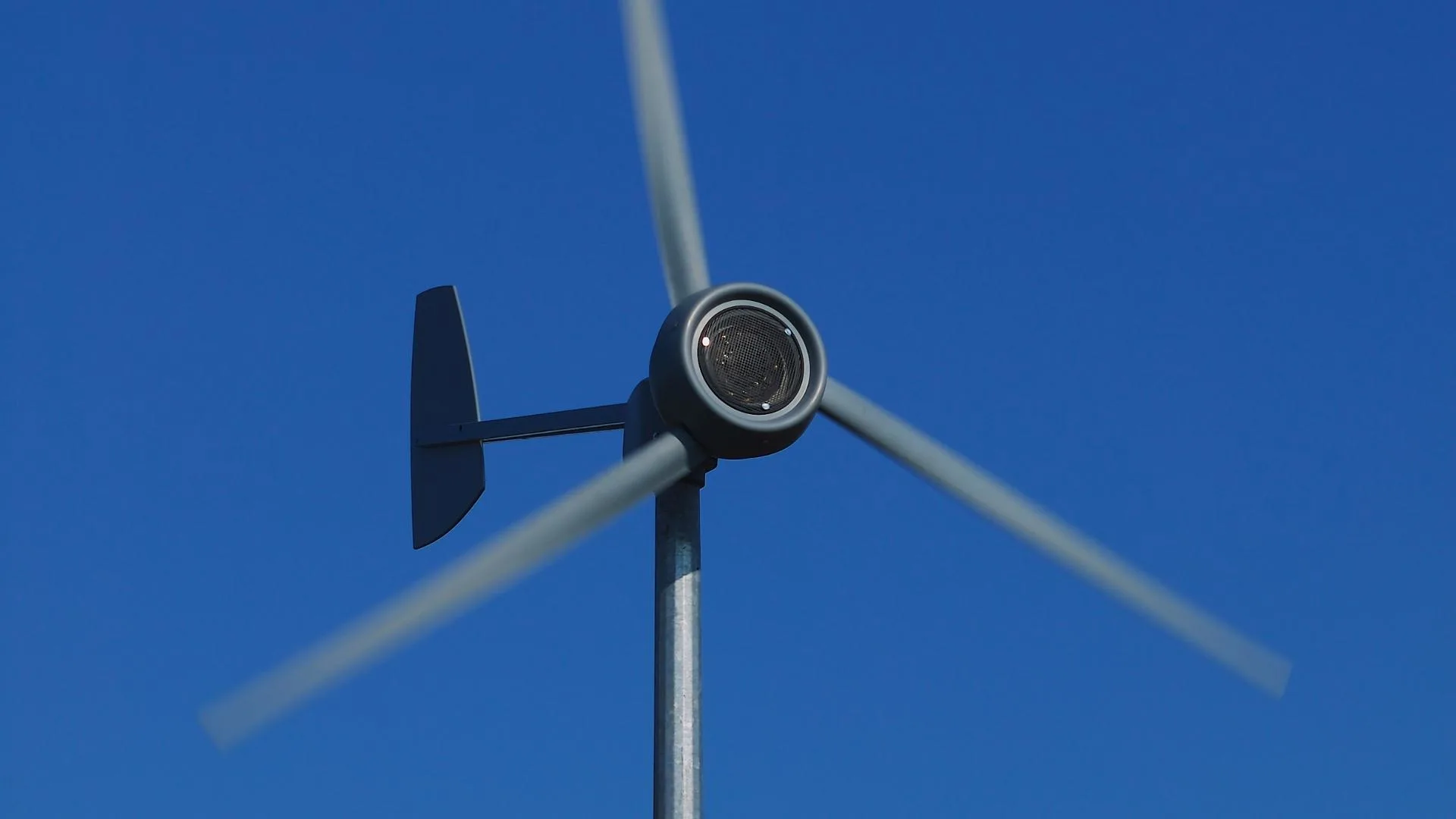
Although wind turbines can generate some power at around 10 mph, they typically require continuous winds of approximately 26-30 mph to produce their maximum rated capacity.
And, unlike the sun which we know will rise every morning and will be present at least to some degree daily, the wind is far less predictable.
Tall Items (Like Wind Turbines On Poles) Can Be Lightning Rods
Wind turbines work best when situated high in the air, with no obstructions nearby to block the wind. Unfortunately, this essentially makes them a lightning rod near or above your RV. Tall pointy objects are the subject of most lightning strikes, as noted in our post “How Safe is an RV in a Lightning Storm?”… so having a wind turbine mounted on a pole nearby your RV is increasing this risk.
Less Productive and Efficient Than Other Options
RV wind turbines are relatively inefficient, especially when compared with other off-grid power options like solar. This is because even given optimal wind speeds, a wind turbine produces less energy and is highly unlikely to fully power the devices and appliances in your RV.
Another problem is that wind turbines require a minimum wind speed, known as the “cut-in speed”, to generate any power at all. If the wind doesn’t reach the cut-in speed, no power is generated.
They also have a “cut-out speed” which is the fastest wind speed a given turbine can handle. Winds that blow faster than this speed risk damaging the wind turbine, and they also generate no additional electricity.
So, all in all, wind turbines require a very specific balance to achieve their maximum output, and even that is unlikely to adequately power your RV.
Need to Be Set Up and Dismantled for Travel
Another disadvantage of RV wind turbines is that every time you move to a new location – or move your rig at all – the wind turbine needs to be lowered or dismantled, and then set up again once you reach your next destination.
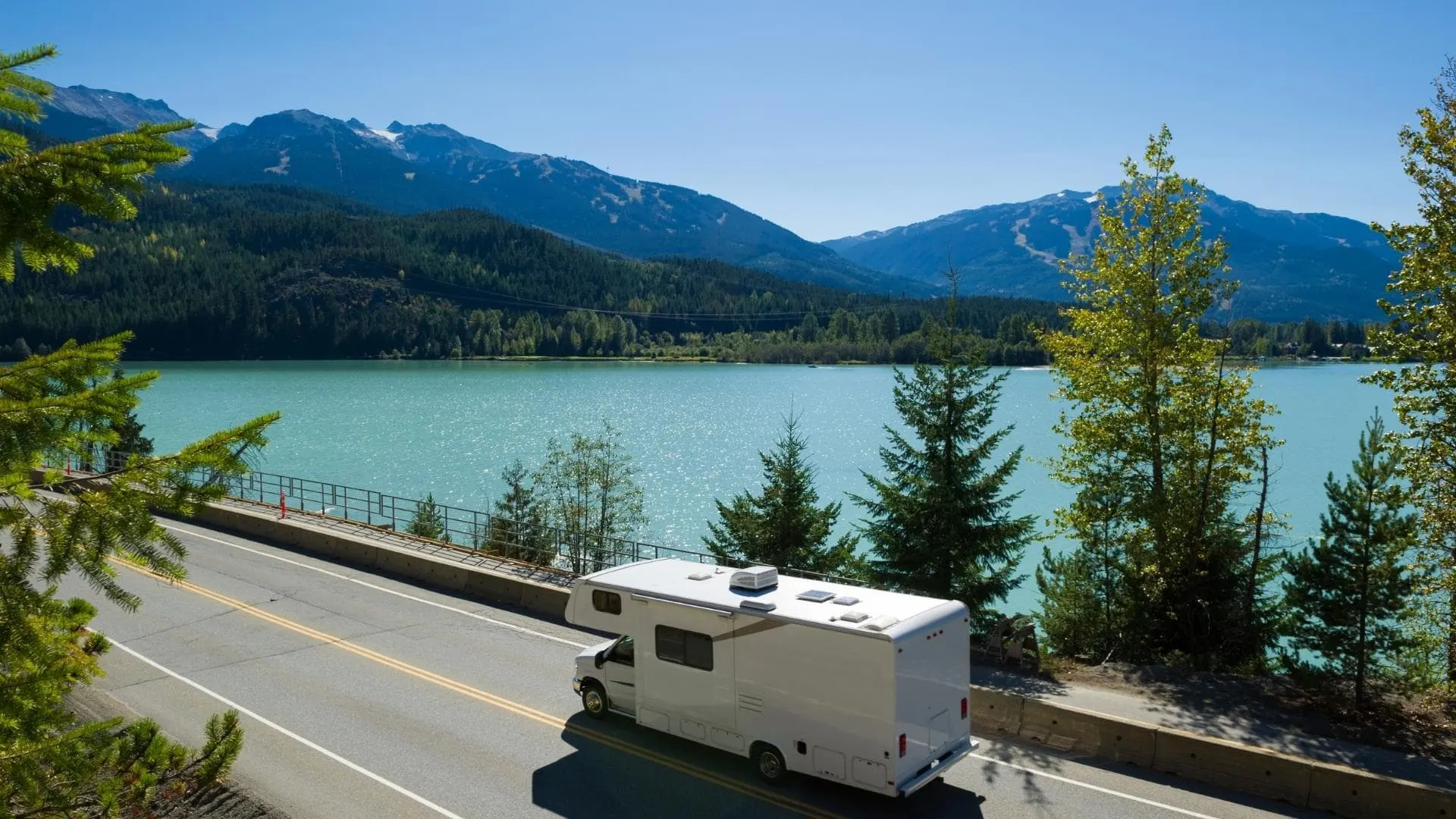
RV wind turbines require dismantling every time you travel to a new destination. Once you arrive at your new camping location, you’ll have to set up the turbine system again. And if your new location is a place where trees or other obstructions are impeding the wind, your turbine may not work at all (though, neither will your solar, most likely ????).
May Be Noisy
Some wind turbines can be quite noisy. The noise they make is often described as “whooshing” and/or “clicking”. If they’re mounted directly to your RV, they can also create vibrations that you’ll feel inside, which can be annoying to some.
Are There Upsides To RV Wind Turbines?
With all of the above said about the cons to using wind to provide power for your RV, there are some upsides. Especially if you’re considering using one as an additional source of power above and beyond your other options (solar or generator). Or, if you have minimal power needs (recharging small portable electronics) and tend to camp in shady areas (bad for solar) with steady winds.
We don’t think wind power is ready to be considered as a complete solution for off-grid power generation, but it does provide an interesting option for augmenting your power needs in certain situations.
Are There Small Portable Wind Turbines for Campers?
There are portable wind turbines on the market. There are even some hybrid kits that combine wind and solar power.
Unfortunately, the units we’ve looked at get very mixed reviews. Let’s take a look at a few:
Pikasola 400W Wind Turbine Generator
This is a 400W 12V wind turbine generator with five blades. It comes with a charge controller and is suitable to be used as part of a hybrid system when used in conjunction with a separate solar power system.
- ★ Feature: Starting with 2.5m/s Low wind speed; Low vibration during working; High wind energy efficiency. Wind turbine kit suitable for boat, RV,...
- ★ Wind Blade: 23.8 inch in length, the longer blade will generate more power. The blades are made of Nylon carbon fiber which special on waterproof,...
LOYALHEARTDY Wind Turbine Generator
This is a 400W 12V portable vertical helix wind power turbine generator kit that also comes with a charge controller. Unlike RV wind turbines with large rotor blades like the one noted above, this wind turbine generates power using a vertical helix, which has advantages because it doesn’t need to aim directly into the wind and, because of the design, is often less susceptible to damage caused by extreme conditions or wind gusts.
This unit is also capable of being used as part of a hybrid system when used in conjunction with a solar panel system.
- ☀【 HIGH QUALITY BLADES 】The blade material is synthetically injection molded with high-strength FRP material. At the same time, the fashionable...
- ☀【 POWERFUL PERFORMANCE 】The vertical wind turbine adopts three-phase AC PMG, it boasts low torque, high-power tracking intelligent...
Nature’s Generator Gold WE System
This hybrid system is an 1800W hybrid (wind and solar) power system with a pure sine wave generator. It comes with a 100W solar panel, and the system can be expanded. The included gasless, silent generator (effectively, a portable battery bank) comes with a cart for mobility, and the solar panel is on wheels for easy movement. This RV wind turbine has five fiberglass blades.
The generator has three 120V AC outlets, two USB ports (3A combined), one 12V DC port (240W max) one expansion port (200A fuse), one charging AC input (90W), and a 200W max solar input, and a 300W max wind input.
The total combined weight of this system as it’s sold is 170 pounds… which is considerable.
- 🌵 What You Can Get:1×1800W Nature's Generator(With cart);1×Nature's Generator 100W Solar Panel(With wheels);1×Wind Turbine(With 5 Fiberglass...
- 🌴 Note:The accessories of the products need to be installed by yourself,but we have placed all the installation tools and detailed installation...
As always, investigate and read reviews.
Shine Turbine
We recently read about one intriguing product in the Indiegogo space. It’s a portable wind turbine the size of a one-liter bottle, invented by Aurea, a Canadian company. Cat Adalay, a mechanical engineer, and Rachel Carr, a designer, invented the product known as the “Shine Turbine”.
The Shine Turbine is wind power that fits in a backpack. Yes, the entire package, including the tripod on which it’s raised, fits in a backpack.
The intent behind the Shine Turbine is to generate power for handheld electronics such as cell phones, tablets, cameras, etc. According to Aurea, in peak conditions, (there’s that little problem again), the Shine Turbine can generate sufficient power to charge a cell phone in 20 minutes.
It weighs three pounds, sets up in two minutes, and has a 12,000 mAh internal battery.
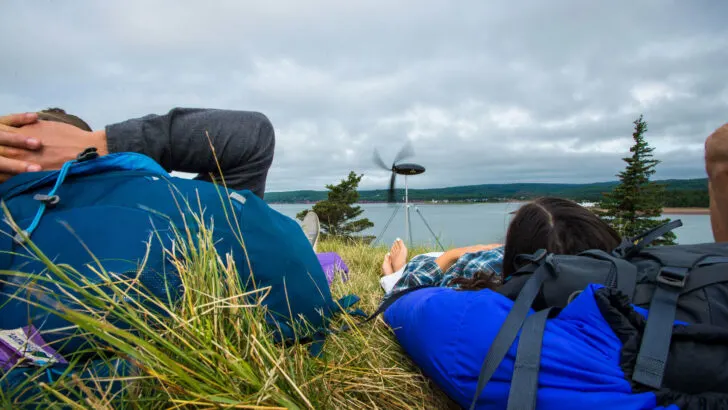
The Shine Turbine is a compact portable wind turbine that fits in a backpack and is capable, (given sufficient wind), of powering small electronics. (Photo credit: Shine Turbine)
This is a great little product for campers, or so it would seem, and we wish them the best with the product which, in addition to generating power for small devices, has also generated a lot of attention.
To see videos of the Shine Turbine at work, check out their Indiegogo page dedicated to this product.
Is an RV Wind Turbine a Good Choice for RVers and Campers?
Wind turbines are certainly environmentally friendly and are capable of generating power all day and all night, given the right weather circumstances. However, those circumstances also mean that you’ll have to camp in windy conditions…and fairly precise ones at that.
If you need to power an entire RV or a number of more power-hungry devices and appliances, it would likely prove to be challenging at best, and you’d do well to invest your money in a solar system, portable generator, or solar generator, instead.
However, if you want to power/recharge a few smaller devices, or if you want to have some backup power in case the sun doesn’t provide enough charging from your solar array, a wind turbine could be a fun way to generate some additional power.
Have You Tried Harnessing the Power of the Wind?
Have you tried using a wind turbine to harness the power of the wind? We’d love to hear from anyone with some wind turbine experience to share. Drop us a comment and tell us all about it!
Geek Out with Us Every Week
Join our newsletter to learn about all things RV-related. Every week we offer free tips, tricks, product reviews, and more to our online community of RVers. So, whether this is your first time on the road or you’re a seasoned expert, we’d love for you to geek out with us!

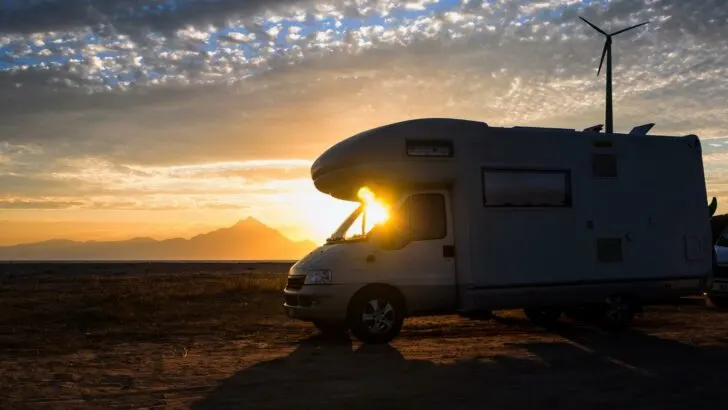



John S.
Saturday 28th of May 2022
Thanks for today's post.
I doubt that many RVers will switch to turbines as a main battery charger, at least in the western half of the continent.(One exception: people who RV near Desert Hot Springs, CA)
But people living/camping on the almost-always-windy east coast might be more intrigued.
I'm glad I read this post because you introduced me to Shine Turbine, a potential gift idea for a son who camps in the mountains.
TheRVgeeks
Sunday 29th of May 2022
LOL! We've always wanted to park near all the Palm Springs/Desert Hot Springs wind turbines... in the hope that there was a big power outlet at the bottom we could plug into! ????????
Larry Barrett
Saturday 28th of May 2022
I have often wondered if a horizontal bank of 4 or 5 or 6 fans in an assembly that mounts across the top of any RV, would harvest the wind power that comes from driving the RV. Now, seeing the references above, it strikes me that the vertical helix blades, rather than rotor blades might suit the design better - for more blades in that 6-8 ft width across the top. If you happen to share this idea with anyone who develops it commercially and they make any money, tell them to send me some.
TheRVgeeks
Sunday 29th of May 2022
Good thought experiment, Larry. But TJL and Joa have pretty thoroughly replied... and adding a bigger/second alternator onto your RV or tow vehicles engine is likely the better bet. True, that too would add some (though minimal) drag on the engine and reduce fuel economy as a result, but it's a lot more efficient than wind turbines on the roof.
Love the out-of-the-box thinking, though!
Joa
Sunday 29th of May 2022
@Larry Barrett, It would probably be easier to add another alternator to your engine and wire it up to charge your online system. It’s definitely more effective and also adds less weight to your vehicle. As T J L correctly said, the additional energy you would harvest through a pretty ineffective win turbine on top of your vehicle has to be created by your gas consuming engine that moves your vehicle forward. It’s surely not very efficient.
TJL
Saturday 28th of May 2022
@Larry Barrett, Simple answer: The energy harvested from driving would come at the expense of additional fuel consumption due to the additional wind resistance of the vehicle.